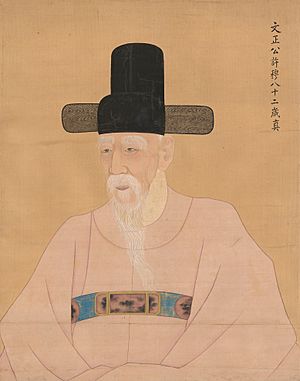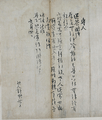Heo Mok facts for kids
Quick facts for kids
Heo Mok
허목 |
|
|---|---|
 |
|
| Right State Councillor | |
| In office August 14, 1675 – April 24, 1678 |
|
| Preceded by | Gwon Dae-un |
| Succeeded by | Min Hui |
| Personal details | |
| Born | January 10, 1596 Cheonseonbang, Hanseong, Kingdom of Joseon |
| Died | June 2, 1682 (aged 86) Wangjing Township, Yeoncheon County, Gyeonggi Province, Kingdom of Joseon |
| Nationality | Korean |
| Spouse | Lady Yi of the Jeonju Yi clan |
| Children |
|
| Parents |
|
| Occupation | Calligrapher, painter, philosopher, poet, politician |
| Korean name | |
| Hangul | |
| Hanja | |
| Revised Romanization | Heo Mok |
| McCune–Reischauer | Hŏ Mok |
| Art name | |
| Hangul | |
| Hanja | |
| Revised Romanization | Misu |
| McCune–Reischauer | Misu |
| Courtesy name | |
| Hangul | |
| Hanja | |
| Revised Romanization | Munbu, Hwabo |
| McCune–Reischauer | Munpu, Hwapo |
| Posthumous name | |
| Hangul | |
| Hanja | |
| Revised Romanization | Munjeong |
| McCune–Reischauer | Munchŏng |
Heo Mok (born January 10, 1596 – died June 2, 1682) was a very important person in Korea during the Joseon Dynasty. He was a talented calligrapher, a painter, a deep thinker (philosopher), a poet, and a politician. He came from the Yangcheon Heo clan. Most people knew him by his special pen name, Misu (미수, 眉叟), which means "the eyebrowed old man."
Heo Mok was famous for his amazing and unique style of Korean calligraphy. Many thought he was the best calligrapher of his time. What's even more interesting is that he became a high-ranking government official, like a governor, when he was 81 years old. He was the first person in Korean history to reach such a high position without passing the special Gwageo civil service exam. This exam was usually required to get important government jobs.
Contents
Heo Mok's Life
Early Years
Heo Mok was born in a place called Changseonbang, which is in Hanseong, the capital city of Joseon. His father, Heo Kyo, worked in the lower levels of the government. His great-grandfather, Heo Ja, had even been a Vice Prime Minister of Joseon.
Heo Mok's family was part of a political group called the Northerners. In Joseon, there were different political groups, like teams, that often disagreed on how the country should be run. Heo Mok learned from important scholars like Yi San-hae and Yi Won-ik when he was young.
In 1613, he married Lady Yi from the Jeonju Yi clan. Her grandfather was Yi Won-ik, one of his teachers.
Starting His Career
From 1615 to 1620, Heo Mok studied at a private school run by Jeong Gu. He learned a lot about philosophy and how to think deeply.
Later, in 1626, he faced a challenge. He was in charge of a student dormitory and accused another scholar of going against important rules. Because of this, he was not allowed to take the Gwageo exam for a while. This made his path to government different from others.
Getting Involved in Politics
Even without the exam, Heo Mok was recognized for his smart ideas. In 1651, he got a job as a teacher for the royal family, but he left after a few years. He held several other government jobs, often for short periods, showing he was a valued scholar.
In 1659, King Hyojong gave Heo Mok more important roles in the government.
The Great Debates: Yesong Arguments
Heo Mok became very famous for his role in two big debates called the "Yesong arguments." These were arguments about how long royal family members should mourn when someone died, based on Confucian rules. These rules were very important in Joseon society.
First Yesong Argument
In 1659, King Hyojong died. He was the second son of the previous king, King Injo, but he became the king. The big question was: how long should Queen Jangryeol, King Injo's second wife, mourn for her stepson, King Hyojong?
- One group, the Westerners, led by Song Si-yeol, said Queen Jangryeol should mourn for only one year. They argued that because Hyojong was the second son, he should be mourned like a regular second son.
- Heo Mok and his group, the Southerners, argued that Queen Jangryeol should mourn for three years. They believed that even though Hyojong was the second son, he became king, so he should be treated as if he were the eldest son and heir.
Heo Mok also argued that Joseon was a unique country, different from China, so it could have its own rules for these traditions. In the end, the government decided on a one-year mourning period, which was a win for the Westerners at that time.
Second Yesong Argument
During this time, Heo Mok wrote important books like Dongsa (Eastern History). In this book, he said that the first ancestor of Korea was Dangun, which was a different idea from what most people believed then.
In 1674, King Hyojong's wife, Queen Inseon, died. This started another debate.
- Song Si-yeol and the Westerners said Queen Jangryeol should mourn for 9 months.
- Heo Mok and the Southerners argued for one year of mourning. They said that since King Hyojong was treated as the main heir, his wife, Queen Inseon, should be treated as the main daughter-in-law.
This time, King Hyeonjong supported Heo Mok and the Southerners. This meant Heo Mok's ideas won, and his political group gained more power. However, King Hyeonjong died soon after.
Gaining More Power
Even after King Hyeonjong's death, Heo Mok was still highly respected. In 1674, he was given many important government jobs, including a very high position as Right State Councillor of Joseon in 1676. This showed how much the new king, King Sukjong, trusted him.
In 1679, Heo Mok even criticized another powerful official, Heo Juk, because Heo Juk's son was misusing his power.
His Final Years
Heo Mok passed away on June 2, 1682, in Gyeonggi Province. He was 86 years old.
After his death, the Westerners group continued to criticize Heo Mok and his ideas. However, in 1689, his reputation was restored, and in 1692, he was given the highest honor, the title of Chief State Councillor, after his death. He was also given the special posthumous title Munjeong (문정, 文正), which means "Cultured and Righteous."
Books by Heo Mok
Heo Mok wrote many books on different topics, showing how smart and learned he was. Some of his famous works include:
- Gyeongnye Yuchan (경례유찬, 1647)
- Dongsa [Eastern History] (동사, 1667)
- Cheongsa Yeoljeon [Blue Gentlemen List] (청사열전, 1667)
- Gyeongseol (경설, 1677)
- Misu Cheonjamun (미수 천자문)
- Dangun Sega Dangun's Family (단군세가)
- Misu Kieun (미수기언)
- Sim Hakdo (심학도)
Images for kids
See also
 In Spanish: Heo Mok para niños
In Spanish: Heo Mok para niños
- List of Korean philosophers
- Korean philosophy
- Song Si-yeol
- Yun Hyu
- Yun Seon-do






